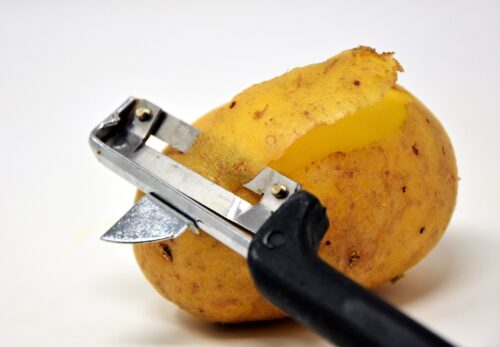Read the 7 best tips and learn How to Repurpose Potato Peels in the Garden and make the good use of this versatile vegetable.
Potatoes are undeniably one of the most versatile vegetables. Though people throw potato peels for their less appealing taste compared to the smooth interior, the fact is that they are packed with nutrients. They contain essential macronutrients like nitrogen, phosphorus, potassium, and micronutrients. Being organic matter, they decompose readily, making these nutrients readily available to plants and enhancing soil quality. Here, you can find How to Repurpose Potato Peels in the Garden.
Read: 7 Best Tricks to Use Dried Banana Peels As A Fertilizer
How to Repurpose Potato Peels in the Garden (7 Tips)

1. Potato Fertilizer
To turn potato skins into garden fertilizer quickly, follow these steps. Peel potatoes and collect the peels in a jar. Fill the jar with water until it covers the skins completely. Let it sit for 3-7 days. Don’t forget to stir gently each day. After this time, strain out the peels from the water. Now, use this nutrient-rich water to pour over your plants. Repeat this process once or twice a month to help your plants thrive and grow robustly.
2. Potato Peels as a Gnat Trap
Are fungus gnats bothering your houseplants? Try using potato peels as a trap. These small pests are drawn to the organic matter in your plant’s soil. Simply place some potato peels on the soil surface to attract fungus gnats for egg-laying. Replace the peels every few days to manage the gnat population. If you notice many adult insects on the peels, you can use diluted dish soap as a natural pesticide. Remember to dispose of the peels before they start to decay.
3. Add Potato Peels to the Compost Pile
It’s worth mentioning the most obvious option: potato peels are great for your compost pile if you save your food scraps. Compost piles work best with a mix of green materials (like food scraps) and brown materials (such as dry leaves and some paper products). The ideal ratio is 1 part green material (including potato peels) to 3 parts brown. When adding potato peels to your compost, ensure you also include plenty of dry materials to maintain balance.
4. Use Cooked Potato Water
Don’t waste the leftover water when you boil potatoes for dinner. Let it cool down, and use it to water your plants. Boiling potatoes releases nutrients and starches from the peels and makes it a cost-effective and fast-acting fertilizer. After cooking, strain out any solids using cheesecloth or a fine kitchen strainer. Water your plants right away or store the potato water in the fridge for later use on indoor or outdoor plants.
5. As a Slug Bait
Slugs, much like fungus gnats, are drawn to organic matter, such as potato peels. To deter them, strategically place your peels in cool, damp areas where slugs tend to congregate, such as near young seedlings, lettuce, and hostas. Check the peels each morning and discard them in the trash when covered with slugs. Replace with fresh peels as needed. For enhanced effectiveness, consider pairing the peels with beer traps to maximize slug attraction and safeguard your plants.
6. Trench Composting
If you don’t have much outdoor space or prefer not to use compost bins, you can still compost potato peels and other food scraps right in your garden. Trench composting is a simple alternative that saves time. Just dig a 6-inch deep trench between your plants. As you gather kitchen scraps, put them in the trench and cover them with soil. The scraps will break down fast with the help of soil microbes. Keep creating trenches like this to nourish your plants continuously.
7. For Seed Starting
If you’re cooking potatoes like russets with thick skins and only using the soft insides, don’t toss the skins! Cut the cooked potatoes in half and scoop out the insides. Then, use the empty potato halves as seed-starting pots. Fill them with a seed starting mix, plant your seeds, and place them in a waterproof container. Keep them well-watered. When your seedlings are ready to transplant, you can plant the whole thing—the potato skin and all. This provides nutrients for the seedling and makes transplanting easier without disturbing the roots.
Read: 17 Amazing Banana Peel Uses in the Garden



